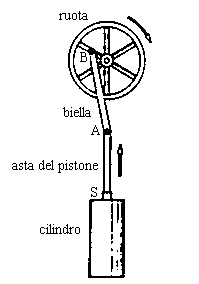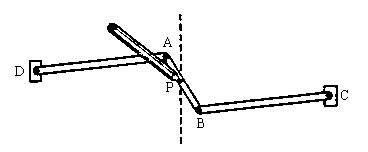| |
|
|

|
One of the problems that engaged engineers in the years between the XVIII and the XIX
centuries was that of finding a useful system to drive the axle of
the piston of a steam engine with a rectilinear alternate
motion.
In order to move according to a rectilinear
alternate motion, the piston rod needs an appropriate mechanism.
Without an appropriate mechanism, in fact, the pitman AB, connecting
the piston with the wheel gathering the motion, would push the piston
rod outside the vertical, damaging rapidly the axle box S.
It is necessary that such a mechanism do not have repent parts, to
avoid strong frictions and the quick attrition of the material.
|
 |
In 1784 James Watt introduced the first device to drive
the axle of the piston of a steam engine
with a rectilinear reciprocating motion.
He used three hinged axles,
two of which, AD and BC, were equally long, while AB was much shorter.
|

|
If C and D are fixed points (at specific, and distinct heights),
when the AB axle is moved, its mean point P seems to describe -
for a considerable length - a vertical rectilinear segment.
"Seems" is the appropriate word because, if we make
a model of the mechanism, we see that it is an approximation.
The complete motion of the articulated system causes the point P
to describe the figure eight. Despite these limitations,
Watt's simple mechanism has been - and continues to be -
widely used in solving the problem of
rectilinear motion without friction.
|
|
|